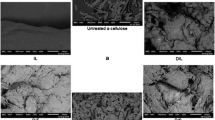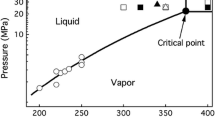Abstract
Microcrystalline cellulose (avicel) is treated in hot-compressed aprotic solvents, sulfolane and 1,4-dioxane, using a batch-type reaction system with a molten tin bath in a range from 290 to 390°C. The corresponding densities of the solvent are 0.25–1.26 g/cm3 and 0.21–1.03 g/cm3 for sulfolane and 1,4-dioxane, respectively. As a result, in both solvents, more than 90% of cellulose is found to be decomposed to the solvent-soluble portion in which levoglucosan is the main component with the highest yield of about 35% on original cellulose basis. The decomposition rate to levoglucosan is, however, faster in sulfolane than in 1,4-dioxane, while levoglucosan is more stable in 1,4-dioxane. In addition, its yield is found to be solvent-density dependent to be highest around 0.4–0.5 g/cm3 for both solvents. To elucidate these decomposition behaviors, the results obtained in this study with aprotic solvents are compared with protic solvents such as water and methanol in previous works.
Similar content being viewed by others
References
Shafizadeh F, Fu Y L. Pyrolysis of cellulose. Carbohy Res, 1973, 29: 113–122
Shafizadeh F. Introduction to pyrolysis of biomass. J Anal Appl Pyrolysis, 1982, 3: 283–305
Shafizadeh F, Furneaux R H, Cochran T G, Scholl J P, Sakai Y. Production of levoglucosan and glucose from pyrolysis of cellulosic materials. J Appl Poly Sci, 1979, 23: 3525–3539
Kwon G-J, Kim D-Y, Kimura S, Kuga S. Rapid-cooling, continuous-feed pyrolyzer for biomass processing Preparation of levoglucosan from cellulose and starch. J Anal Appl Pyrolysis, 2007, 80: 1–5
Dobele G, Rossinskaja G, Dizhbite T, Telysheva G, Meier D, Faix O. Application of catalysts for obtaining 1,6-anhydrosacchadides from cellulose and wood by fast pyrolysis. J Anal Appl Pyrolysis, 2005, 74: 401–405
Piskorz J, Majerski P, Radlein D, Vladars-Usas A, Scott D S. Flash pyrolysis of cellulose for production of anhydro-oligomers. J Anal Appl Pyrolysis, 2000, 56: 145–166
Ehara K, Saka S. A comparative study on chemical conversion of cellulose between the batch-type and flow-type systems in supercritical water. Cellulose, 2002, 9: 301–311
Sasaki M, Fang Z, Fukushima Y, Adschiri T, Arai K. Dissolution and hydrolysis of cellulose in subcritical and supercritical water. Ind Eng Chem Res, 2000, 39: 2883–2890
Sakaki T, Shibata M, Miki T, Hirousue H, Hayashi N. Decomposition of cellulose in near-critical water and fermentability of the products. Energ Fuel, 1996, 10: 684–688
Sakaki T, Shibata M, Miki T, Hirousue H, Hayashi N. Reaction model of cellulose decomposition in near-critical water and fermentation of products. Bioresour Technol, 1996, 58: 197–202
Saka S, Ueno T. Chemical conversion of various celluloses to glucose and its derivatives in supercritical water. Cellulose, 1999, 6: 177–191
Ishikawa Y, Saka S. Chemical conversion of cellulose as treated in supercritical methanol. Cellulose, 2001, 8: 189–195
Köll P, Borchers G, Metzger J O. Thermal degradation of chitin and cellulose. J Anal Appl Pyrolysis, 1991, 19: 119–129
Reichardt C. Solvents and Solvent Effects in Organic Chemistry. Weinheim: VCH, 1988
Parker A J. Protic-dipolar aprotic solvent effects on rates of biomolecular reactions. Chem Rev, 1969, 69(1): 1–32
Tondo D W, Jr Pliego J R. Modeling protic to dipolar aprotic solvent rate acceleration and leaving group effects in SN2 reaction. J Phys Chem A, 2005, 109: 507–511
Voronova M I, Lebedeva T N, Radugin M V, Surov O V, Prusov A N, Zakharov A G. Interactions of water-DMSO mixtures with cellulose. J Mol Liq, 2006, 126: 124–129
Kawamoto H, Hatanaka W, Saka S. Thermochemical conversion of cellulose in polar solvent (sulfolane) into levoglucosan and other low molecular-weight substances. J Anal Appl Pyrolysis, 2003, 70: 303–313
Yamada T, Ono H. Rapid liquefaction of lignocellulosic waste by using ethylene carbonate. Bioresour Technol, 1999, 70(1): 61–67
Hosoya T, Kawamoto H, Saka S. Oxime-trimethylsilylation method for analysis of wood pyrolysate. J Anal Appl Pyrolysis, 2006, 77: 121–126
Sekiguchi Y, Frye J S, Shafizadeh F. Structure and formation of cellulosic chars. J Appl Poly Sci, 1983, 28: 3513–3525
Julien S, Chornet E, Tiwari P K, Overend R P. Vacuum pyrolysis of cellulose: Fourier transform infrared characterization of solid residues, product distribution and correlations. J Anal Appl Pyrolysis, 1991, 19: 81–104
Schwanninger M, Rodrigues J C, Pereira H, Hinterstoisser B. Effects of short-time vibratory ball milling on the shape of FT-IR spectra of wood and cellulose. Vib Spectr, 2004, 36: 23–40
Kawamoto H, Saka S. Heterogeneity in cellulose pyrolysis indicated from the pyrolysis in sulfolane. J Anal Appl Pyrolysis, 2006, 76: 280–284
Mok W S, Antal M J. Formation of charcoal from biomass in a sealed reactor. Ind Eng Chem Res, 1992, 31: 1162–1166
Saka S, Ehara K, Minami E. Efficient utilization of woody biomass with supercritical fluid technologies. Mokuzai Gakkaishi (in Japanese), 2005, 51: 207–217
Author information
Authors and Affiliations
Corresponding author
Additional information
Supported by the National Natural Science Foundation of China (Grant No. 90610035)
Rights and permissions
About this article
Cite this article
Bao, G., Shiro, S. & Wang, H. Cellulose decomposition behavior in hot-compressed aprotic solvents. Sci. China Ser. B-Chem. 51, 479–486 (2008). https://doi.org/10.1007/s11426-008-0052-1
Received:
Accepted:
Published:
Issue Date:
DOI: https://doi.org/10.1007/s11426-008-0052-1




